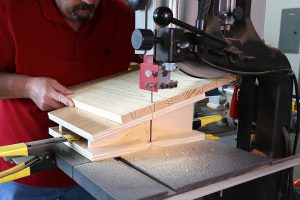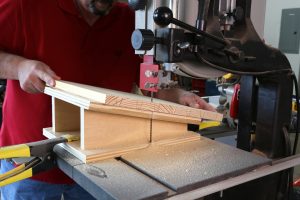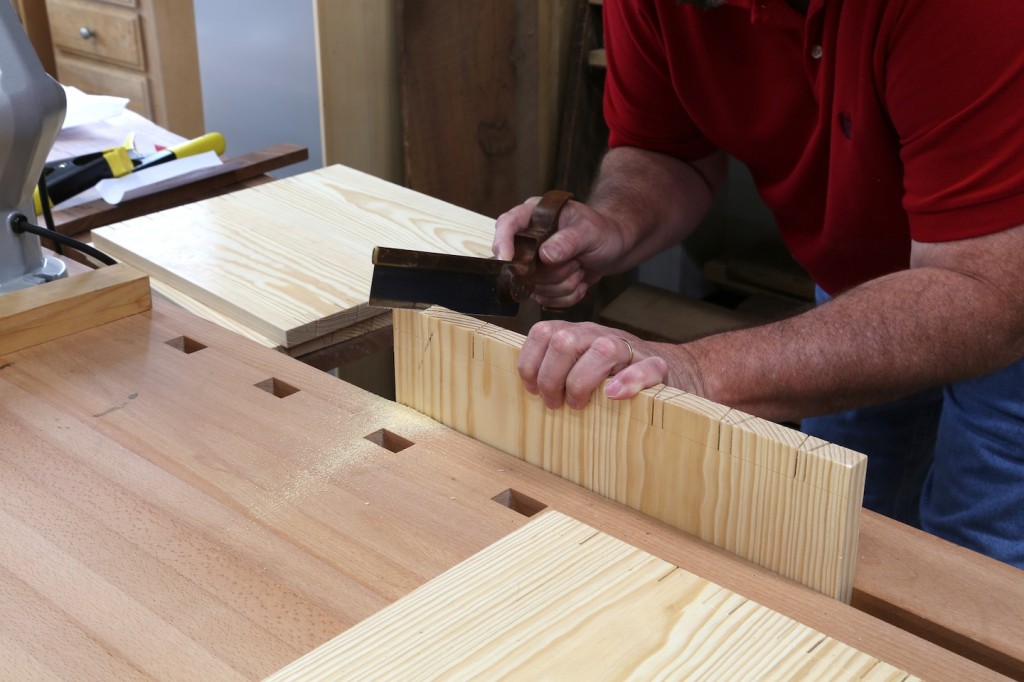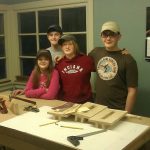We may receive a commission when you use our affiliate links. However, this does not impact our recommendations.
 Years ago, I stumbled upon this woodworking jig. Years since, it still ranks high in usage when I’m working on a large number of dovetails (but I generally teach and make hand-cut dovetails).
Years ago, I stumbled upon this woodworking jig. Years since, it still ranks high in usage when I’m working on a large number of dovetails (but I generally teach and make hand-cut dovetails).
It’s a simple-to-build jig – as are most of the jigs we use here at the magazine and those published in “55 Best Shop-Made Jigs.” And it’s a real timesaver in the shop. A top bed and bottom base sandwich two supports that are cut on an appropriate angle for dovetails. I use 12° because the angle is not too sloped and not too flat, and I like the look. (There is, on period pieces I’ve looked at, no historical evidence that 8:1 or 6:1 measurements were strictly followed.)
Setup is easy. Place it on your band saw table, then cut into the jig just a bit so you have support right at the blade. Be careful that you don’t constantly push the jig into the blade. (After years of use while teaching, my home-shop jig is all but cut through the supports.) One way to hold the jig steady is with spring clamps, as you see in the photo above. If the Popular Woodworking Magazine shop band saw did not have a granite top, I would install rare-earth magnets into the bottom to hold the jig still.
To use the jig, position your workpiece to the blade, make sure you are aligned with the correct angle of your pin board layout, then make the cut right at and straight down your layout line. Move to the next line where the layout angle also matches the slope of the cut and saw it. Continue across the end of your board until all the cuts are made – half of all the pins are sawn.
 To cut the other side of each pin – and here’s the cool part – simply reverse the jig as shown in the photo at right. After you turn the jig, the angle of cut reverses to align with the remaining layout line to complete your pins. It’s that easy.
To cut the other side of each pin – and here’s the cool part – simply reverse the jig as shown in the photo at right. After you turn the jig, the angle of cut reverses to align with the remaining layout line to complete your pins. It’s that easy.
If I’m cutting the pins and tails for a single board, or even two boards, I’ll grab my backsaw and have at it. But if I have a lot of cuts to make, give me the jig.
There are, of course, limitations to this jig. Those are the same limitation set forth by your band saw. If the board does not fit between the band saw blade and the saw’s support column, you will not be able to cut the entire pin layout. What do you do in that case? Grab your backsaw and have at it.
For more information on dovetails, take a look at:
Chuck Bender’s DVD “Dovetailing Apprenticeship” or my DVD “Cheating at Hand-cut Dovetails.” (The jig described above is used in the DVD.)
Here are some supplies and tools we find essential in our everyday work around the shop. We may receive a commission from sales referred by our links; however, we have carefully selected these products for their usefulness and quality.










I just wish everyone would use either degrees or slope and never use both! isn’t 8:1 equal to 12.5 degrees?
Thanks Glen
Have not done 1 dovetail yet.
But am working up to it….perhaps in July?
You are being a great help.
If the board is too wide for the band saw, why not flip the board and finish the rest of the cuts at that angle?